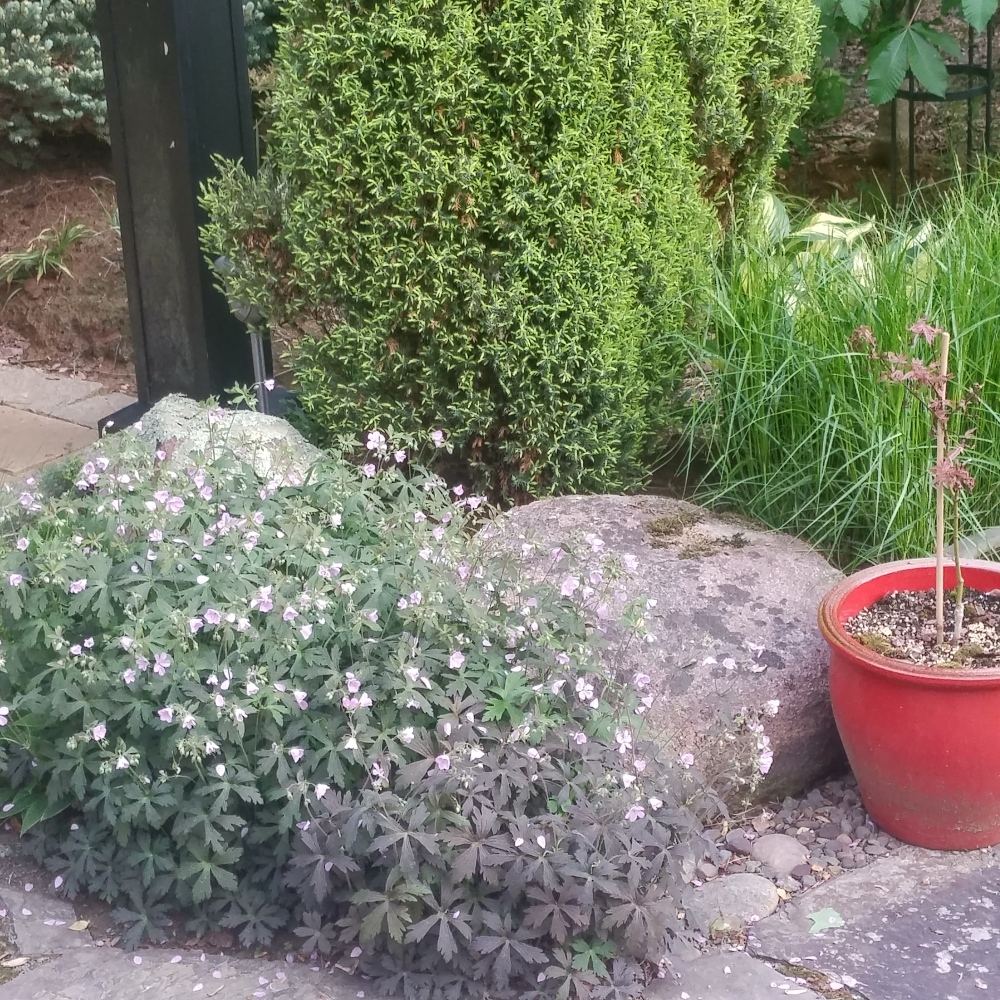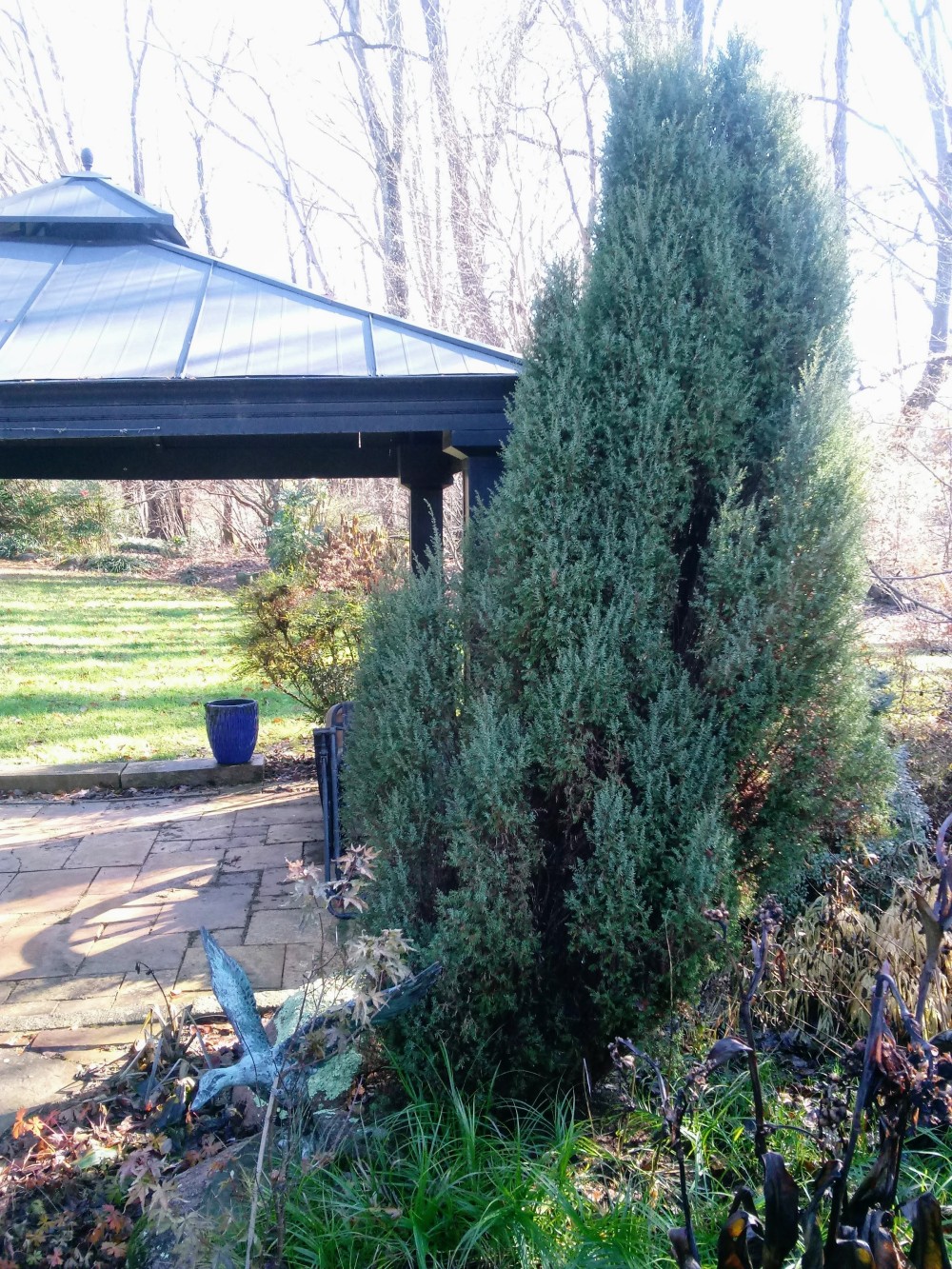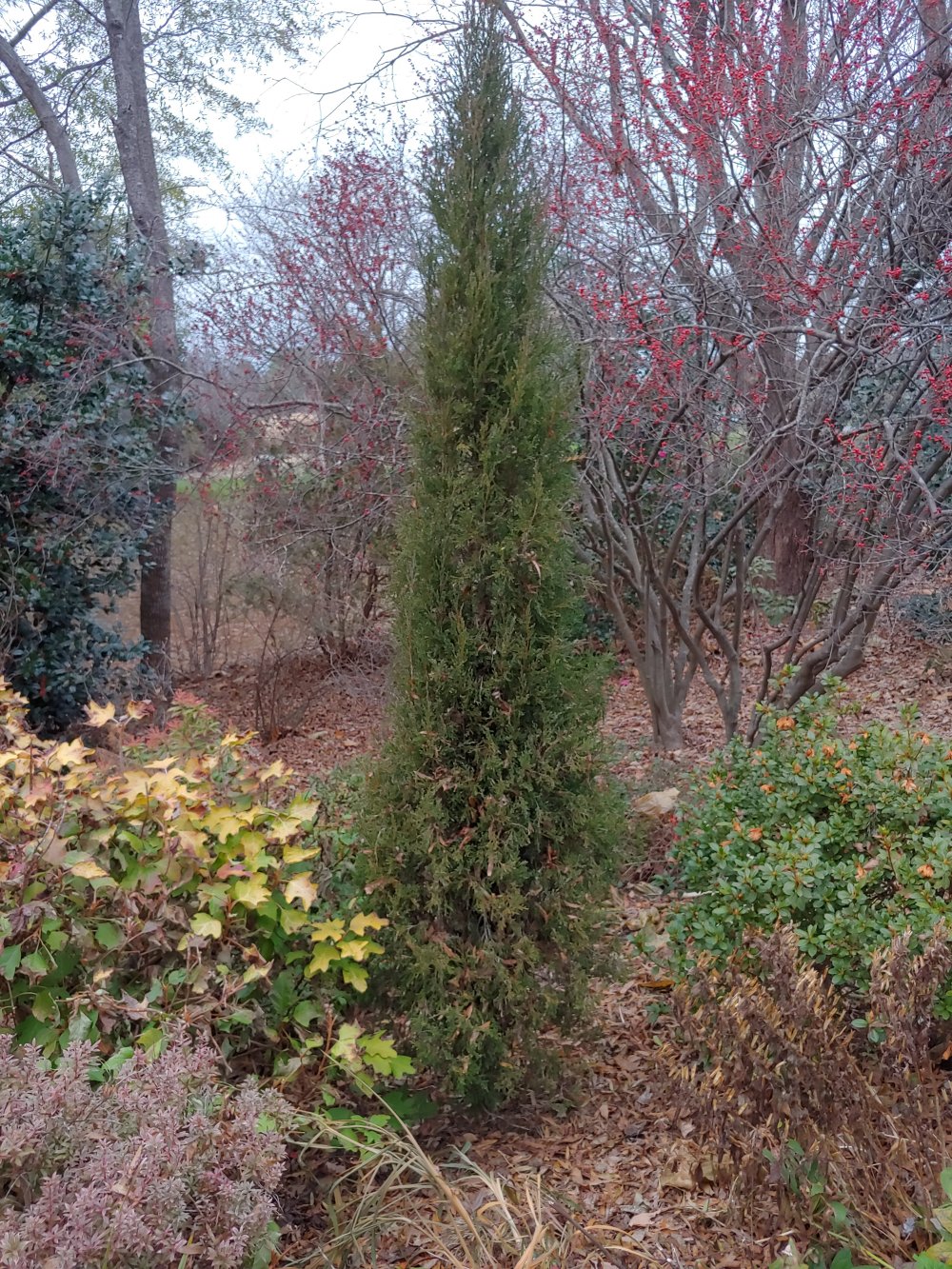In recent years, ice, snow, and wind have irreparably damaged and tilted a tall ‘Gold Cone’ juniper (Juniperus communis ‘Gold Cone’), that must now be removed. No matter that ‘Gold Cone’ was never gold, with barely a trace of yellow new growth in spring that faded quickly in the first spell of heat. It was planted for its narrow, upright form, which it held until ice and snow bent branches. Then, prolonged winds in a March nor’easter earlier this year bent the juniper several degrees out of plumb.

I recall the old Irish juniper (Juniperus communis ‘Hibernica’), common a few decades ago, but rarely seen nowadays, probably for some of the reasons I’m seeing that are troubling with ‘Gold Cone’. I think the old Irish juniper had problems browning in the middle, and ‘Gold Cone’ doesn’t do this enough to be an issue, but similar to other multi-stemmed, upright shrubs, it is susceptible to breaking apart in ice or snow.

Perfect is not required in this garden, but there are limits, and the tilting is a step too far. As with any subtraction from the garden, it will look a bit odd when the juniper is first removed, but it’s hardly as if there’s not enough other planting in the area. Certainly, I’ll consider something else to fill the spot, probably another evergreen of some sort, but I’ll wait until something pops up that I can’t live without (which happens frequently).
Some time ago, a columnar Blue spruce grew to twenty feet tall, and though it had a strong central leader, after every wet snow its fastigiate shape became more broad. Finally, the combination of its odd shape, and a slow fade as this part of the garden became shadier, made the decision to chop it out quite easy. The stump remains, somewhere under newer plants that filled the void.
In another part of the garden, ‘Taylor’ (Juniperus virginiana ‘Taylor’, above), a blue-green, narrow, upright growing version of our native redcedar, has grown nearly ten feet tall, but barely over a foot wide. The juniper has much more of a central leader, and so far the effects of ice and snow (and our March nor’easter) have not been a problem.
Comings and goings are not unusual in the garden. The gardener hopes for fewer, but the final demise of the ‘Gold Cone’ juniper, after years of near misses, is hardly a disappointment. Whatever goes in to replace it is likely to be an improvement.
Are dwarf varieties of upright fastigate evergreens susceptible to becoming more broad, like the columnar blue spruce?
I’m wondering if my T. occidentalis degroots spire will develop problems with heavy snow (and if it this will stay under 8 feet)
https://mrmaple.com/products/buy-thuja-occidentalis-degroots-spire-columnar-arborvitae
Smaller branches on the fastigiate spruce were bent by snow, while the main trunk remained upright. I would have lived with the distorted shape, but lower branches began to fail in the shade. In the end, this was addition by subtraction. Years later, I’m happy with the change.
With DeGroot’s Spire, I recommend preventative action to protect against damage from ice and snow. A loose wrap in the winter months of twine or nylon web fabric will keep branches from bending. I’ve seen this problem many times with the popular Emerald Green arborvitae and Sky Pencil holly, both of which are usually multi trunked. I suspect that DeGroot’s is also multi trunked, so it will also be susceptible to splaying in snow and ice. I have tried to go out in heavy snow storms to brush snow off susceptible evergreens, but when I go to bed at midnight after brushing snow off, and wake at 6am with another foot, I see that prevention is the better policy. Also, I believe DeGroot’s will grow to nearly 20 feet tall, and not to only 8 feet. It is considerably narrower than other arborvitae, but not a dwarf.
Dear Dave, I feel sorry for the Gold Juniper! Why not trim it back just a bit? It looks so healthy. And, I’m sure it’s very happy in the garden! Anyway, have a good day and thanks for the pictures! 😀
I’m afraid the juniper is past the point of repair. I’ve pruned branches in the past that were bent from snow and ice, but I doubt that pruning or any other repair can fix its current tilt. I am very slow to give up on a plant, but the time has come for Gold Cone to go away.
It looks silly, but at least you got it! Junipers have such a stigma here, the some of the best are rare. Eastern red cedar are not even available. I see a few in old landscapes, but I do not know where they came from. I have two seedlings, which will not be very useful in a landscape; but I like them for what they are. ‘Skyrocket’ juniper is sometimes available.
Upright junipers have made a comeback in this area. For years we could barely give them away as junipers faded in popularity in general, both low and taller growing types. From a practical standpoint, when used for screening, junipers do not get as large as the ubiquitous Green Giant arborvitae, and most are resistant to deer. At one time we planted a fair number of Skyrocket and other Juniperus scopulorum, but these brown out too much to be worthwhile in this area.
Yes, I heard about the diseases with Juniperus scopulorum cultivars, but have never seen them. Is supposedly can happen on the coast.